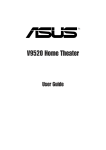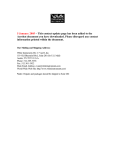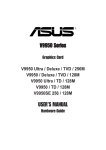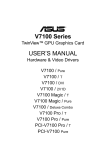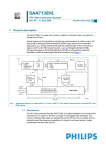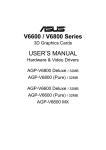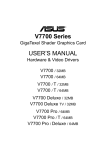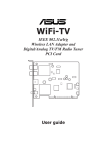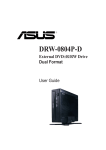Download Asus TV FM 7135 User`s manual
Transcript
® TV FM Card PCI-based TV FM Card USER’S MANUAL Hardware & Video Drivers NOTICES No part of this manual, including the products and software described in it, may be reproduced, transmitted, transcribed, stored in a retrieval system, or translated into any language in any form or by any means, except documentation kept by the purchaser for backup purposes, without the express written permission of ASUSTeK COMPUTER INC. (“ASUS”). ASUS PROVIDES THIS MANUAL “AS IS” WITHOUT WARRANTY OF ANY KIND, EITHER EXPRESS OR IMPLIED, INCLUDING BUT NOT LIMITED TO THE IMPLIED WARRANTIES OR CONDITIONS OF MERCHANTABILITY OR FITNESS FOR A PARTICULAR PURPOSE. IN NO EVENT SHALL ASUS, ITS DIRECTORS, OFFICERS, EMPLOYEES OR AGENTS BE LIABLE FOR ANY INDIRECT, SPECIAL, INCIDENTAL, OR CONSEQUENTIAL DAMAGES (INCLUDING DAMAGES FOR LOSS OF PROFITS, LOSS OF BUSINESS, LOSS OF USE OR DATA, INTERRUPTION OF BUSINESS AND THE LIKE), EVEN IF ASUS HAS BEEN ADVISED OF THE POSSIBILITY OF SUCH DAMAGES ARISING FROM ANY DEFECT OR ERROR IN THIS MANUAL OR PRODUCT. Product warranty or service will not be extended if: (1) the product is repaired, modified or altered, unless such repair, modification of alteration is authorized in writing by ASUS; or (2) the serial number of the product is defaced or missing. Products and corporate names appearing in this manual may or may not be registered trademarks or copyrights of their respective companies, and are used only for identification or explanation and to the owners’ benefit, without intent to infringe. • Windows, MS-DOS, and DirectX are registered trademarks of Microsoft Corporation. • Adobe and Acrobat are registered trademarks of Adobe Systems Incorporated. The product name and revision number are both printed on the product itself. Manual revisions are released for each product design represented by the digit before and after the period of the manual revision number. Manual updates are represented by the third digit in the manual revision number. For previous or updated manuals, BIOS, drivers, or product release information, contact ASUS at http://www.asus.com.tw or through any of the means indicated on the following page. SPECIFICATIONS AND INFORMATION CONTAINED IN THIS MANUAL ARE FURNISHED FOR INFORMATIONAL USE ONLY, AND ARE SUBJECT TO CHANGE AT ANY TIME WITHOUT NOTICE, AND SHOULD NOT BE CONSTRUED AS A COMMITMENT BY ASUS. ASUS ASSUMES NO RESPONSIBILITY OR LIABILITY FOR ANY ERRORS OR INACCURACIES THAT MAY APPEAR IN THIS MANUAL, INCLUDING THE PRODUCTS AND SOFTWARE DESCRIBED IN IT. Copyright © 2004 ASUSTeK COMPUTER INC. All Rights Reserved. Product Name: Manual Revision: Release Date: 2 ASUS TV FM Card Revised Edition V4 E1612 April 2004 ASUS TV FM Card User’s Manual ASUS CONTACT INFORMATION ASUSTeK COMPUTER INC. (Asia-Pacific) Address Telephone Web site 150 Li-Te Road, Peitou, Taipei, Taiwan 112 +886-2-2894-3447 www.asus.com.tw Technical Support Telephone(MB/Component) (Notebook) (Server/PC) (Networking) Support fax +886-2-2890-7121 (English) +886-2-2890-7122 (English) +886-2-2890-7123 (English) +886-2-2890-7902 (English) +886-2-2890-7698 ASUS COMPUTER INTERNATIONAL (America) Address Fax E-mail Web site 44370 Nobel Drive, Fremont, CA 94538, USA +1-510-608-4555 [email protected] usa.asus.com Technical Support Telephone (General) (Notebook) Support fax Support e-mail +1-502-995-0883 +1-510-739-3777 +1-502-933-8713 [email protected] ASUS COMPUTER GmbH (Germany and Austria) Address Telephone Fax Online contact Harkort Str. 25, D-40880 Ratingen, Germany +49-2102-95990 +49-2102-959911 www.asuscom.de/sales Technical Support Telephone Fax Online support Web site +49-2102-95990 +49-2102-959911 www.asuscom.de/support www.asuscom.de/news ASUS COMPUTER (Middle East and North Africa) Address Telephone Fax Web site P.O. Box 64133, Dubai, U.A.E. +9714-283-1774 +9714-283-1775 www.ASUSarabia.com ASUS TV FM Card User’s Manual 3 CONTENTS I. Introduction .......................................................................... 7 Highlights .............................................................................................. 7 Getting started ....................................................................................... 8 2. Hardware Setup .................................................................... 9 Operating System Requirements ..................................................... 9 ASUS TV FM Card Layout ........................................................... 10 Installation Procedures ................................................................... 11 Connecting the Audio .................................................................... 12 Connecting the Audio .................................................................... 12 Using Your TV FM Card ............................................................... 13 Using the Remote Control ............................................................. 15 Installing Batteries ......................................................................... 15 ASUS Remote Controller Layout .................................................. 16 ASUS Remote Controller Functions .............................................. 17 3. Software Setup .................................................................... 21 Device Driver Installation .............................................................. 21 Windows 2000/XP .............................................................................. 21 Method 1: ASUS Quick Setup Program ....................................... 21 Method 2: Plug and Play .............................................................. 22 Install DirectX ..................................................................................... 24 Uninstall the TV FM Card Drivers ..................................................... 25 Windows 2000 / XP ...................................................................... 25 Method : Using Control Panel ................................................ 25 Install ASUS Home Theater ................................................................ 26 Install VideoSecurity ........................................................................... 27 Install PowerDirector Pro ................................................................... 28 4. Software Reference ............................................................. 29 ASUS Home Theater ..................................................................... 29 PowerDirector Pro ......................................................................... 31 ASUS VideoSecurity ..................................................................... 33 5. Resolution Table .................................................................. 38 6. Troubleshooting .................................................................. 40 4 ASUS TV FM Card User’s Manual Notices Federal Communications Commission Statement This device complies with FCC Rules Part 15. Operation is subject to the following two conditions: • This device may not cause harmful interference, and • This device must accept any interference received, including interference that may cause undesired operation. This equipment has been tested and found to comply with the limits for a Class B digital device, pursuant to Part 15 of the FCC Rules. These limits are designed to provide reasonable protection against harmful interference in a residential installation. This equipment generates, uses and can radiate radio frequency energy and, if not installed and used in accordance with manufacturer’s instructions, may cause harmful interference to radio communications. However, there is no guarantee that interference will not occur in a particular installation. If this equipment does cause harmful interference to radio or television reception, which can be determined by turning the equipment off and on, the user is encouraged to try to correct the interference by one or more of the following measures: • Reorient or relocate the receiving antenna. • Increase the separation between the equipment and receiver. • Connect the equipment to an outlet on a circuit different from that to which the receiver is connected. • Consult the dealer or an experienced radio/TV technician for help. WARNING! The use of shielded cables for connection of the monitor to the graphics card is required to assure compliance with FCC regulations. Changes or modifications to this unit not expressly approved by the party responsible for compliance could void the user’s authority to operate this equipment. Canadian Department of Communications Statement This digital apparatus does not exceed the Class B limits for radio noise emissions from digital apparatus set out in the Radio Interference Regulations of the Canadian Department of Communications. This Class B digital apparatus complies with Canadian ICES-003. Cet appareil numérique de la classe B est conforme à la norme NMB-003 du Canada. Macrovision Corporation Product Notice This product incorporates copyright protection technology that is protected by method claims of certain U.S. patents and other intellectual property rights owned by Macrovision Corporation and other rights owners. Use of this copyright protection technology must be authorized by Macrovision Corporation, and is intended for home and other limited viewing uses only unless otherwise authorized by Macrovision Corporation. Reverse engineering or disassemby is prohibited. ASUS TV FM Card User’s Manual 5 6 ASUS TV FM Card User’s Manual I. Introduction 1. Introudction Highlights/Models Thank you for purchasing ASUS TV FM card. The TV FM card that provides a total solution suitable for watching TV programs, making scheduled recordings, capturing video from TVs or camcorders, and making movies on your PC. The ASUS TV FM CARD introduces a new dimension in video quality by incorporating the newest video/audio decoder for enhanced performance, functionality and enjoyment. Combined with the ASUS remote control and useful software bundle, the ASUS TV FM CARD lets your PC be a smart multimedia center! Highlights • Use the advanced video/audio decoder - Philips with two 9-bit video ADC for excellent video quality • Built-in TV FM tuner • Enjoy the ultimate entertainment package ~ Allows you to easily watch TV, tune to FM radio, listen to MP3s, view DVD/VCDs, pictures and video on your PC. • Provides you with complete TV experience on your PCs. ~ “Automatic Channel Scanning”, “Channel Surfing”, “Pre-schedule Recording (MPEG1/2). • Support STEREO and Dual modes while watching TV • Come with a remotes control for the ultimate in convenience • Video-in connector for external video stream • Let you capture/edit/author/burn your favorite videos and images in one software package • Build your own video security and monitoring system • WDM video capture driver for Windows 2000/XP • Microsoft® DirectShowTM compliant • PCI revision 2.2 compliant ASUS TV FM Card User’s Manual 7 I. Introduction 1. Introudction Highlights/Models Getting Started The following steps will help you get your ASUS TV FM Card connected and working quickly and assume that your computer is shut down and turned off. 1 Unpack your ASUS TV FM Card pagkage. Shown here are the TV FM card and accessories. ASUS TV FM card • Cables (1) Multi video-in and audio-in cable for connection to video camera or camcorder (2) Audio cable for connection to sound card • Software (1) ASUS installation driver CD (2) ASUS Home Theater software CD (3) CyberLink PowerDirector software CD • Remote control with transmitter, receiver and batteries • ASUS TV FM Card user’s manual 2 Connect cables and other accessories. • • 3 Install batteries in remote control. • 4 Details are on page 15. Start your computer. 5 Install the Device drivers. • 6 Details for installing the software to run your FM card are on page 21. Install the DirectX. • 7 Details for installing the software to run your FM card are on page 27. Installing software. • 8 Details for installing the software to run your FM card are on page 30. Using software. • 8 Details for connecting a cable TV system and home antenna to your FM starts on page 10. Details for connecting other devices to your FM card are on page 12. Details for using the software to run your FM card are on page 33. ASUS TV FM Card User’s Manual 2. Hardware Setup Operating System Requirements • Intel® or AMD® chipset-based mainboard recommended • One available PCI compliant slot • Minimum 64 MB system memory • VGA card with 16MB memory above 2. H/W Setup • CD-ROM drive (for driver installation) • Sound card needed • Microsoft Windows® 2000/XP • DirectX® 8 or above needed NOTES • To avoid damage to your TV FM card, unplug your computer’s power supply before inserting your FM card into the PCI slot. • Videoconferencing requires the addition of a video camera or video camcorder. ASUS TV FM Card User’s Manual 9 10 ASUS TV FM Card User’s Manual ASUS Driver and Utility CD User’s Manual ASUS TV FM Card Item Checklist Video (S-VHS) inport Video (Composite) inport Audio(R) inport Audio(L) inport Antenna CATV FM Radio Video&Audio (S-VHS) inport Cable/ Antenna inport FM inport R PHILIPS SAA7135HL Video-Audio Decoder Audio-out port Motherboard ® Use the same TV standard for all devices. Antenna and CATV cannot be connected at the same time. Drawings are for reference only, actual card layout may vary. Notes • • • 8275 Philips Silicon Tuner 8290 Philips Digital IF TV-7135LP Sound Card 2. H/W Setup ASUS TV FM Card 2. Hardware Setup 2. Hardware Setup NOTE: This TV FM card can only be installed in motherboards with a PCI slot. 2. H/W Setup WARNING! Computer boards and components contain very delicate Integrated Circuit (IC) chips. To protect the computer board and other components against damage from static electricity, you must follow some precautions. 1. Make sure that you unplug your power supply when adding or removing expansion cards or other system components. Failure to do so may cause severe damage to both your motherboard and expansion cards. 2. Keep all components such as the host adapter in its antistatic bag until you are ready to install it. 3. Use a grounded wrist strap before handling computer components. If you do not have one, touch both of your hands to a safely grounded object or to a metal object, such as the power supply case. Hold components by the edges and try not to touch the IC chips, leads, or circuitry. 4. Place components on a grounded antistatic pad or on the bag that came with the component whenever the components are separated from the system. Installation Procedures New FM Card 1. 2. 3. 4. 5. 6. 7. 8. 9. 10. Unplug all electrical cords on your computer. Remove the system unit cover. Locate the PCI bus expansion slot. Make sure this slot is unobstructed. Remove the corresponding expansion slot cover from the computer chassis. Ground yourself to an antistatic mat or other grounded source . Pick up the board (still in its sleeve) by grasping the edge bracket with one hand and then remove the plastic sleeve. Position the card directly over the PCI slot and insert one end of the board in the slot first. Firmly but gently press the bus connector on the bottom of the card down into the slot. Be sure the metal contacts on the bottom of the host adapter are securely seated in the slot. Anchor the board’s mounting bracket to the computer chassis using the screw from the slot cover that you set aside previously. Replace the cover on the system unit. Connect cables and devices, if available. ASUS TV FM Card User’s Manual 11 2. Hardware Setup Connecting the Audio You may connect the audio portion either to a sound card or directly to the audio connector in your motherboard. Follow the procedure below to connect the audio. 2. H/W Setup Sound Card 1.Locate the JP1 connector on the ASUS TV FM Card. 2.Locate the Line-In (JP Audio-input) connector on your sound card. If necessary, refer to the documentation supplied with your sound card. 3.Attach one end of the sound cable to the JP1 connector of the ASUS TV FM Card and the other end to the Line-In (JP Audio-input) on your sound card. TV-7135LP Audio-out port 8290 Philips Digital IF Sound Card PHILIPS 8275 Philips Silicon Tuner SAA7135HL Video-Audio Decoder R Motherboard 1.Locate the JP1 connector on the ASUS TV FM Card. 2.Locate the Line-In (JP Audio-input) connector on your motherboard. If necessary, refer to the documentation supplied with your motherboard. 3.Attach one end of the sound cable to the JP1 connector of the ASUS TV FM Card and the other end to the Line-In (JP Audio-input) on your motherboard. TV-7135LP Audio-out port ® 8290 Philips Digital IF 8275 Philips Silicon Tuner PHILIPS Motherboard SAA7135HL Video-Audio Decoder R 12 ASUS TV FM Card User’s Manual 2. Hardware Setup Using Your TV FM Card There are three general steps in using or setting-up your TV FM Card. 2. H/W Setup Step 1 Disconnect the CATV system or antenna from your TV system. Step 2 Reconnect the CATV system or antenna to your TV FM Card. Step 3 Connect the included and other accessories to your TV FM Card. CATV/Home Antenna Connections There are various types of cable TV (CATV) and antenna connections. Each type requires a different method of connection. NOTE Consult your dealer for the type of adaptor, splitter, A/B switch or combiner that may be required when setting up your TV FM Card. Your TV FM Card is capable of receiving up to 100 channels. If you do not have a CATV system, you may use an indoor or outdoor antenna that carries only VHF (channels 2–13), only UHF (channels 14–69), or VHF and UHF channels to connect to your TV FM Card. Your CATV sytem or antenna may be connected in either of the following two ways: direct to the TV or through a VCR system. Connection Through a TV System CATV Antenna Connection Through a VCR System CATV Antenna To start using your TV FM Card, follow the steps and sketch on the following pages to connect a CATV system or home antenna to your TV FM Card. ASUS TV FM Card User’s Manual 13 2. Hardware Setup Step 1 Disconnect the CATV system or antenna from your TV system. 2. H/W Setup CATV Antenna Disconnection from a TV System CATV Antenna Disconnection from a VCR System Step 2 Reconnect the CATV system or antenna to your TV FM Card. TV FM Tuner Card TV Card Antenna CATV CATV Cable/ Antenna Connector Direct Connection TV Card TV FM Tuner Card Antenna CATV CATV Cable/ Antenna Connector Connection Through either an Adaptor, Splitter, A/B Switch or Combiner 14 ASUS TV FM Card User’s Manual 2. Hardware Setup Using the Remote Control (Optional) 2. H/W Setup The Remote Control allows you to operate the VCR/ DVD at a distance. It has all the major controls necessary for operating your FM card, such as turning your TV on/off, viewing the TV, and changing the channels and volume. Aim the front of the Remote Control at the Remote Control Receiver and press the control buttons as you would on the infrared rays receiver. The remote control receiver may be placed anywhere, as long as it is not blocked Installing Batteries Open the back cover of Remote Controller and put in one CR2032 battery. If the Remote Control does not operate or fails to function normally, replace the batteries. The Remote Control operates on one CR2032 3-volt battery. Installing receiver of ASUS remote control kit Plugging receiver (with USB port on it) into the USB port of your computer and have the receiver grip on the top of computer panel or your favorite location for easy operation. ASUS TV FM Card User’s Manual 15 2. Hardware Setup ASUS Remote Controller ASUS Remote Controller Layout 16 ASUS TV FM Card User’s Manual 2. Hardware Setup Remote Control Functions Button Mode 1 Mode 2 Mode 3 Mode 4 TV Mode - - - - FM Radio - - - - DVD Mode - Close App Close App Close App Close App Rewind Tune Down Rewind - Stop Stop Stop - Play/Pause Play/- Play/Pause - Fast Forward Tune Up Fast Forward - TV Audio - - - Mute Mute Mute - ASUS TV FM Card User’s Manual 17 2. Hardware Setup Button Mode 1 Mode 2 Mode 3 Mode 4 Record Record - - Full Screen - Full Screen - Channel Up/Down 18 Search Forward Next Chapter / / Search Previous Backward Chapter - Volume Volume Volume Up/Down Up/Down Up/Down - 1 1 1 - 2/Up 2/Up 2/Up - 3 3 3 - 4/Left 4/Left 4/Left - ASUS TV FM Card User’s Manual 2. Hardware Setup Button Mode 1 Mode 2 Mode 3 Mode 4 5/Enter 5/Enter 5/Enter - 6/Right 6/Right 6/Right - 7 7 7 - 8/Down 8/Down 8/Down - 9 9 9 - Back Back Back - 0 0 0 - Number Lock Number Lock Number Lock - ASUS TV FM Card User’s Manual 19 Features: 1. Innovation design of ASUS Remote Controller for controlling ASUS Home Theater software with desktop PC. 2. Mouse mode can be used as mouse function while you aren’t in front of your computer. 3. Receiver with USB Port, it’s easy to connect with your computer. Specifications: • Operation Voltage : 3V ; Battery : 1 x CR2032 • Receiver Inter face : USB Port 20 ASUS TV FM Card User’s Manual 3. Software Setup Device Driver Installation You can use the below method to install the device drivers for your FM card, depending on your operating system. NOTE: The screens displayed in this manual may not exactly reflect the screen contents displayed on your screen. The contents of the support CD are subject to change at any time without notice. Windows 2000 / XP Method 1: ASUS Quick Setup Program 1. Start Windows. 3. S/W Setup 2. Windows detects the ASUS TV FM card and displays the Found New Hardware Wizard window. Click Cancel. 3. Insert support CD into your CD-ROM drive.The Install Shell appears. Click FM Driver on the dialog box. 4. Follow succeeding onscreen instructions. ASUS TV FM Card User’s Manual 21 3. Software Setup 5. Setup has finished installing all the necessary files on your computer, Click Finished to complete Setup. Windows 2000 / XP Method2 : Plug and Play 3. S/W Setup 1. Start Windows and insert support CD into your CD-ROM drive. 2. Windows detects the ASUS TV FM card and displays the New Hardware Found window. 3. Click Next to allow Windows to search for the required driver. 4. Select the option Search for a suitable driver for my device (Recommended) and Click Next. 22 ASUS TV FM Card User’s Manual 3. Software Setup 5. Check the option CD-ROM drives and Click Next. 3. S/W Setup 6. When the wizard finds the driver location, click Next to install the driver. 7. Click Finish when Windows has finished installing the driver. ASUS TV FM Card User’s Manual 23 3. Software Setup Install DirectX Microsoft DirectX allows 3D hardware acceleration support in Windows 98, Windows 2000, and Windows XP. For Software MPEG support in Windows 98, you must first install Microsoft DirectX, and then an MPEG-compliant video player. 1. Insert the CD installation disc into your CD-ROM drive or double click the CD drive icon in My Computer to bring up the autorun screen or run Setup32.exe in the directory \AutoRun of your CD-ROM drive. Click DirectX Runtime Libraries. 3. S/W Setup 2. The DriectX(R) Setup box appears. Click Install button to install driver. 3. The installation program will automatically install the DirectX 8.1 runtime libraries into your system. 4. Setup will prompt when it has finished copying all the files to your computer. Click OK to finish the installation. 24 ASUS TV FM Card User’s Manual 3. Software Setup Uninstall the TV FM Card Drivers If you want to update your TV FM Card drivers or if you no longer need the TV FM Card drivers for your card, you can use following procedures to completely uninstall the drivers from your system to save disk space. Windows 2000 / XP Method : Using Control Panel 1. Click Start, and then point to Settings. 3. S/W Setup 2. Click Control Panel. 3. Double-click the Add/Remove Programs icon. 4. Click the Change/Remove Programs icon. 5. Click ASUS TV FM Card Drivers from the list. 6. Click Change/Remove. 7. The system prompts a confirmation dialog box. Click OK to completely remove all TV FM card components, otherwise, click Cancel. ASUS TV FM Card User’s Manual 25 3. Software Setup 8. Click Finish to complete setup and restart computer. 3. S/W Setup Installing ASUS Home Theater The ASUS Home Theater enables you to watch TV, listen to MP3s, view DVDs or video clips and browse pictures on your PC. 1. Insert the ASUS Home Theater support CD into your CD-ROM drive. 2. Double click the CD drive icon in My Computer to bring up the autorun screen or run Setup.exe in the root directory of your CD-ROM drive. 3. From the welcome screen, click Next and follow succeeding instructions to copy the necessary files to your computer. 26 ASUS TV FM Card User’s Manual 3. Software Setup 4. Click on Finish to complete setup. Install VideoSecurity 3. S/W Setup VideoSecurity is a powerful video stream comparison and detection utility that helps in detecting potential errors or intrusions at a specific time interval by using a video capture device, such as a digital camera. 1. Insert the support CD into your CD-ROM drive. 2. Double click the CD drive icon in My Computer to bring up the autorun screen or run Setup32.exe in the directory \AutoRun of your CD-ROM drive. 3. From the main menu, click ASUS VideoSecurity. 4. When the Welcome box appears, click Next to start the installation. 5. Follow succeeding on-screen instructions or prompts to complete setup. ASUS TV FM Card User’s Manual 27 3. Software Setup Install PowerDirector Pro Ever thought about directing your own movie? How about having all the creative controls and being in charge of the entire editing and post-production process? Well, today’s computing technology has made all this possible for anyone who has recording devices, capture devices, acomputer, and of course, the sensational new software application, PowerDirector. 1. Insert the support CD into your CDROM drive 2. Double click the CD drive icon in My Computer to bring up the autorun screen . 3. S/W Setup 3. Select the language from the choices then click Next. 4. The PowerDiector Pro Setup window appears. Click Next to start the installation. 5. Follow on-screen instructions or prompts to complete installation. 28 ASUS TV FM Card User’s Manual 4. Software Reference ASUS Home Theater 4. S/W Reference The ASUS Home Theater is an integrated software with various multimedia applications. It allows you to enjoy multimedia entertainment such as watching TV, tuning to FM radio, listening to MP3s, playing DVDs, sorting and viewing video or pictures in one friendly user interface. You can easily turn your PC into a multimedia center with ASUS Home Theater! A. Watch TV on your PC! • • • • TV Recording Multi-channel previewing Scheduled recording Still image capture B. Tune to FM Radio on your PC! • • • • • Program listening Program recording Channel scanning Station seeking Station setting ASUS TV FM Card User’s Manual 29 4. Software Reference C. Enjoy MP3s on your PC • • • Listening to MP3 music Radio recording and playback Information display D. Sort Videos on your PC! • 4. S/W Reference • • • • Sort recordings fromt TV/DVD/ Video Display recordings from TV/DVD/ Video Instant Preview feature Still image capture Slide show with music E. Sort pictures on your PC! • • • • Sort pictures from TV/DVD/Video Display pictures from TV/DVD/ Video Instant preview feature Print pictures F. Play DVD/VCD on your PC! • • • 30 DVD/VCD playback Still image capture feature 5.1 channel audio support ASUS TV FM Card User’s Manual 4. Software Reference PowerDirector Pro Ever thought about directing your own movie? How about having all the creative controls and being in charge of the entire editing and post-production process? Well, today's computing technology has made all this possible for anyone who has recording devices, capture devices, a computer, and of course, the sensational new software application, PowerDirector. 4. S/W Reference Admittedly, video editing software is not without its drawbacks. Since the advent of computers and its incredible growth in usage and processing speed power, video editing software applications have taken off to astronomical heights. Yet, a great inherent limitation, such as requiring a huge amount of disk space because of the raw video data it captures, still remains. This is why many still choose to edit with analog devices. What makes PowerDirector the megastar of its industry in one quick flash is its ability to save precious producing time because of its Smart Video Rendering Technology (SVRT). Say goodbye to raw video data, which is usually captured in .AVI format, and say hello to plenty of hard drive space with the MPEG and AVI formats. No additional compression nor decompression is required when producing scenes with MPEG or AVI formats that do not contain effects, which saves you huge amounts of time compared to our competitors that compress and decompress the entire movie! ASUS TV FM Card User’s Manual 31 4. Software Reference Additional SVRT features includes: • altering video speeds • detecting scenes • a disc wizard that creates and burns movie discs in a cinch! • adding titles to clips • adding audio streams to clips • picture-in-pictures (adding video or images to an existing video clip) • a huge collection of transitions, video and titles effects • master audio files • watermarks 4. S/W Reference 32 ASUS TV FM Card User’s Manual 4. Software Reference ASUS VideoSecurity The ASUS VideoSecurity lets you detect intruders into your system and environmental changes and monitor a specified location or any incoming visitor. If VideoSecurity detects any deviation from the norm that you set, it may give an error message or not. Regardless of any messages, VideoSecurity will record: • The last two detected snapshot image files from the video captured stream (saved into a access file named watch dog.mdb). Any image processing or editing software can then be used to view, modify, or distribute them. Limitations Because of differences in hardware sensitivity, VideoSecurity may not completely detect all possible errors. Before you execute VideoSecurity, there are some limitations you have to understand so that you can appropriately use it. • Due to changing temperatures, the captured image of some CCDs will be twisted, which may give a wrong detection. • If the features (e.g., color, luminance) of the object are similar to that of background, the object may not be detected clearly. • The CCD cannot capture the object smoothly and immediately when an object moves too fast. 4. S/W Reference VideoSecurity is designed for the widest environments possible and error conditions, therefore it is necessary to tune the parameters in VideoSecurity Setup Wizard to get the best detection results. Setup Wizard Setup Wizard guides you through setting up the VideoSecurity features. 1. To open Setup Wizard, click the Start button, and then point to Programs, ASUS Video Security, and then click Setup Wizard. The Video Security Setup Wizard dialog box appears. ASUS TV FM Card User’s Manual 33 4. Software Reference NOTE: The following descriptions are only for selected features of the ASUS VideoSecurity utility. For a full description of the features described in this manual and other features, refer to the ASUS VideoSecurity Online Help (HTML) format included with your support CD. You may also click the Help button to open the online help file. Detecting Sensibility This is an important parameter when setting up VideoSecurity. Your environment may change often but VideoSecurity is concerned only when there is a change in the environment. Make sure that you select a suitable sensitivity for your environment. Detecting Interval(frame/sec) This sets the scan rate. Default is 2 frames/sec. The higher the scan rate, the more accurate is the detection. Higher rates, however, entails a higher CPU usage. Do not use a high rate when you plan to use VideoSecurity while using other applications. Working Directory 4. S/W Reference The Working Directory is the folder where the utility stores its temporary working and log files. The default is C:\VIDEOSEC. The directory is user-configurable. When VideoSecurity is ran, a sub-directory automatically created under the main directory, using the current date and time as the folder name. For example, “1999.11.30_12.30.20” means that VideoSecurity was started on 30 November 1999 at 12:30:20 PM. Do not change the working folder’s name while VideoSecurity is running. Otherwise, a fatal runtime error will occur. Detect Region • Full window detects all visible area when watchdog function is on. • User define region detects only the area defined by the user when watchdog function is on. Feature will take effect only when VideoSecurity runs the next time. Window Style • Normal Window is the default style, that is, VideoSecurity will function as a standard Windows program. • Minimized as a tray icon lets you hide the main VideoSecurity window. This is useful when you don’t want anyone to know you are monitoring. When this option is selected, the VideoSecurity icon will appear on the taskbar in the lowerright corner of your screen. Whenever VideoSecurity detects a problem, it will run. You may also run VideoSecurity by clicking the icon. • Always on Top is like a Normal Window except that the main window and control panel is shown always on top of other programs or utilities. You may right click to enable or disable this function at the main window anytime. 34 ASUS TV FM Card User’s Manual 4. Software Reference Working Mode Click the Working Mode tab to define tracing procedure. VideoSecurity not only detects errors or problems in your card, but also detects an intrusion. This box appears when an error occurs. Use this Tracing Box to choose the error processing method for tracing. Handling Procedure 4. S/W Reference Click the Handling Procedure tab to set up personalized handling procedure through Recording, Send email, Make phone call or Execute specific program. VideoSecurity will execute procedures set up by the user once any error is detected. Devices Click the Devices tab to select capture devices and video standard. Use mouse to fine tune the Video Security screen and then click OK when done. ASUS TV FM Card User’s Manual 35 4. Software Reference Running ASUS VideoSecurity Click the ASUS icon on the taskbar’s status area. Clicking this icon opens the ASUS Control Panel, then click the ASUS VideoSecurity to run VideoSecurity. Detect Region Click the Detect Region button to define your VideoSecurity video window. Use your mouse to drag your intended rectangular region. 4. S/W Reference 36 ASUS TV FM Card User’s Manual 4. Software Reference Show History 4. S/W Reference Click the Show History button to see the abnormal situation record including the date, time, and other information. ASUS TV FM Card User’s Manual 37 5.Capture Resolution Table Capture resolution table Video Standard Supported Resolution NTSC/PAL 720X576, 704X576, 352X288, 240X176, 720X480, 640X480, 352X240, 176X144, 720X288, 720X240 640X288, 640X240 320X240, 240X180 160X120 International TV Systems and Standards IMPORTANT! Because systems and standards may change or grow, the information below are provided only as reference. Be sure that the TV FM Card model that you purchased is appropriate for the system and standard of the country where you will be installing TV FM Card. For example, you should have the NTSC model if you plan to use your TV FM Card in countries with NTSC systems, or PAL/SECAM systems. Country TV 5. 5. Resolution Resolution Albania B/G Argentina N Australia B/G Austria B/G Azores Is. (Portugal) B Bahamas M Bahrain B Barbados N Belgium B/G Bermuda M Brazil M Bulgaria D Canada M Canary Is B China D Colombia N Cyprus B Czech Republic D/K Denmark B Egypt B Faroe Islands (DK) B Finland B/G France E/L Gambia I Germany B/G Germany (prev East) B / G Gibraltar B Greece B/H Hong Kong I 38 Color PA L PA L - N PA L PA L PA L NTSC PA L NTSC PA L NTSC PA L - M SECAM NTSC PA L PA L NTSC PA L S E C A M / PA L PA L SECAM PA L PA L SECAM PA L PA L S E C A M / PA L PA L SECAM PA L Stereo Subtitles FM-FM FM-FM Teletext Teletext Nicam Teletext MTS MTS CC Nicam TeleText Nicam TeleText Antiope FM-FM TeleText Nicam ASUS TV FM Card User’s Manual 5.Capture Resolution Table Hungary Iceland India Indonesia Iran Ireland Israel Italy Jamaica Japan Jordan Kenya Korea Luxembourg Madeira Madagascar Malaysia Malta Mauritius Mexico Monaco Morocco Netherlands New Zealand North Korea Norway Pakistan Paraguay Peru Philipines Poland Portugal Romania Russia Saudi Arabia Seychelles Singapore South Africa South Korea Spain Sri Lanka Sweden Switzerland Tahiti Ta i w a n Thailand Trinidad Tunisia Tu r k e y TV Color Stereo B/G & D/K B B B H I B/G B/G M M B B M B/G B B B B/G B M L/G B B/G B/G D/K? B/G B N M M D/K B/G G D/K B I B I N B/G B/G B/G B/G KI M B M B B PAL (was SECAM)Nicam (Budapest only) PA L PA L PA L SECAM PA L Nicam TeleText PA L Nicam TeleText PA L FM/FM TeleText SECAM NTSC Matrix PA L PA L NTSC PA L TeleText PA L SECAM PA L PA L SECAM NTSC MTS CC S E C A M / PA L SECAM PA L FM-FM TeleText PA L Nicam TeleText SECAM PA L Nicam PA L PA L NTSC NTSC PA L Teletext PA L Nicam Teletext PA L SECAM SECAM PA L PA L PA L NTSC PA L Nicam PA L PA L Nicam Teletext PA L FM-FM TeleText SECAM NTSC PA L NTSC SECAM PA L TeleText ASUS TV FM Card User’s Manual Subtitles 5. 5. Resolution Resolution Country 39 6. Troubleshooting 6. Troubleshooting Description Recommended Action My monitor is not capable • It depends on the display characteristics of your of high resolution or refresh monitor. Consult your monitor documentation for the rate. proper configuration. D i re c t X o r t h e o t h e r • Windows 95 is not OSR2.1 or later. applications report no • DirectX version is not 6.0 or later. AGP memory available. • You have not installed appropriate drivers for the AGP chipset. (e.g. VGARTD.VXD for Intel 440LX). • Incorrect BIOS setting. BIOS must support at least 64MB for AGP aperture size. My MPEG player displays • You must install DirectX 8 or later so that your player can take advantage of the hardware acceleration bad quality video clips. mode (DirectDraw). • Try to switch to a lower resolution, color depth, or refresh rate. Switching to a lower mode allows your player to use hardware acceleration mode. • Switch dual view mode to VGA or TV mode. I am using Video Security • This is a very important issue when you decide to use VideoSecurity with the “never stop” option. You and it seems my hard disk must be aware of the free space of your hard disk— space is almost exhausted. it must be enough for storing temporary files in the current working directory. If disk space is exhausted, VideoSecurity will not store any information and give you a warning message. 40 ASUS TV FM Card User’s Manual









































